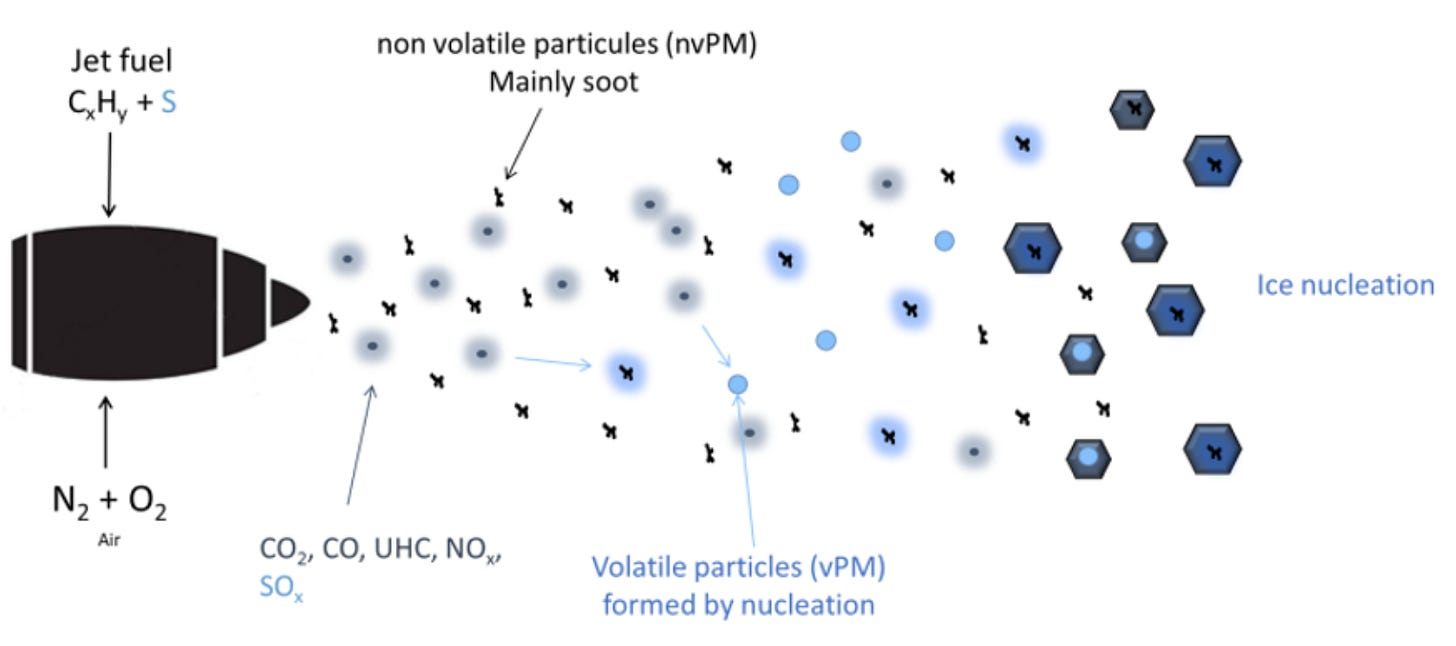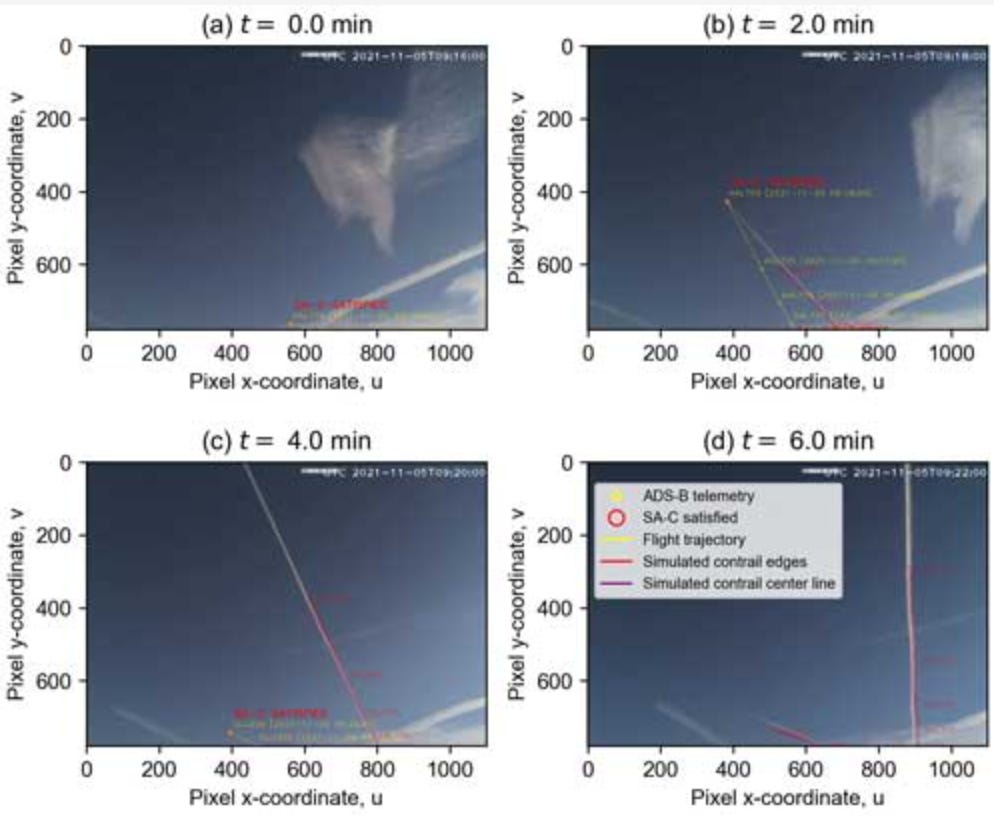The Latest in the World of Contrails
A Look at Some of the Most Recent News and Insights
A captivating chapter in the saga of aviation contrails has unfolded in recent months, with a succession of activity and critical developments in the ongoing global effort to understand, predict, and mitigate their climate impact. These ephemeral brushstrokes across the firmament are not just eye-catching patterns, but a climatic force to be reckoned with. From groundbreaking in-flight experiments with alternative fuels to advanced modeling tools and even surprising legislative action, the scientific and aviation communities are intensifying their focus on this complex atmospheric phenomenon.
Here are 11 noteworthy news stories related to contrails from the first half of this year, highlighting the multifaceted approaches being taken to address their climate impact.
World's First In-Flight Measurements of Hydrogen Aircraft Contrails Completed
In a significant step towards climate-compatible flight, Airbus, the Perlan team, and the German Aerospace Center (DLR) successfully conducted the world's first in-flight measurements of contrails from a hydrogen-powered turbojet engine . This three-week flight test campaign took place in December 2024 in Minden, Nevada and measured the microphysical properties of hydrogen combustion contrails under real atmospheric conditions. Scientists believe hydrogen contrails may form differently, potentially having fewer and larger ice crystals than conventional contrails, which could reduce their warming effect, though further validation is needed.
Four of the seven test flights successfully produced contrails from the hydrogen engine. The precious data gathered from these airborne escapades will fuel global models and help to predict the true climate impact of a future filled with hydrogen-powered aircraft. This pioneering project even earned a nod as a finalist for the prestigious National Aeronautic Association’s Collier Trophy.
Largest Live Contrail Avoidance Trial Demonstrates Significant Climate Impact Reduction
A landmark trial conducted during the second half of 2024 by French regional airline Amelia, in partnership with Thales and Breakthrough Energy Contrails, yielded promising results in contrail mitigation. The findings, released in February 2025, showed that altering flight altitudes to avoid contrail formation could prune the climate impact of selected flights by up to 40%. This initiative, involving five flights from Paris to Valladolid, is considered one of the largest live contrail avoidance trials to date.
While altitude changes resulted in an average increase of up to 3% in fuel consumption due to less optimal flying, the trial underscores the potential of operational mitigation strategies yielding a large climate benefit for a small price. It also demonstrates the potential efficacy of targeting even only a small fraction of flights responsible for causing the majority of warming contrails.
National Academies Calls for Coordinated U.S. Contrail Climate Research Plan
Recognizing the urgent need for a unified approach, the National Academies of Sciences, Engineering, and Medicine released a report in May 2025 calling for a coordinated national research agenda on contrails. "Developing a Research Agenda on Contrails and Their Climate Impacts” charts a national research agenda for the U.S. to better grasp, quantify, and devise both technical and operational remedies for the climate impact of aviation-induced cloudiness and persistent contrails.
The initiative aims to support the global economic competitiveness of the U.S. civil aviation industry in the context of emerging international aviation regulations that require monitoring of non-CO2 impacts.
Airbus Launches PACIFIC Program to Advance Contrail Mitigation Research
Airbus, alongside 10 European partners including Rolls-Royce and Neste, initiated the PACIFIC (Particle emissions, Air Quality and Climate Impact related to Fuel Composition and Engine Cycle) project in March 2025. This EU-funded project will study the impact of contrails on local air quality and climate and provide crucial data inputs for cost-benefit assessments of various types of fuels and potential fuel-related regulations.
PACIFIC will test an unprecedented range of fuels from lab-scale experiments to full aircraft engine ground tests to understand how fuel composition and engine settings influence soot formation, fine particle release, and ultimately, ice crystal formation in contrails. This will include scrutinizing conventional Jet A-1 and selecting three special blends for ground-based tests designed to conjure repeatable contrails. It is easier to measure emissions on the ground than in flight, so that’s where they will start. However, the temperature, pressure, and humidity conditions would need to be replicated in an enormous cold chamber.
U.S. States Trying to Ban “Chemtrails”
Eight U.S. states, including Louisiana, Florida, and Tennessee, have introduced legislation to ban so-called “chemtrails.” Louisiana’s SB46 became law in June and prohibits “intentionally inject[ing], release[ing], apply[ing], or dispers[ing], by any means a chemical, chemical compound, substance, or apparatus into the atmosphere within the borders of this state for the express purpose of affecting the temperature, weather, climate, or intensity of sunlight.”
These legislative efforts are driven by popular conspiracy theories, despite the scientific consensus that aircraft contrails are a well-known physical phenomenon resulting from water vapor and particulate matter rapidly cooling in jet engine exhaust. Critics warn that such laws, based on beliefs rather than evidence, can divert focus from pressing climate issues and erode the voice of science.
New Research Highlights the Role of Volatile Particles in Contrail Activation
Shifting to the microscopic world of contrail formation, new research has shed light on previously underestimated actors. A preprint released in May 2025 by the European Geosciences Union (EGU) details an updated microphysical model for particle activation in contrails. This research emphasizes the critical role of volatile particulate matter (vPM) in contrail activation which originates from fuel sulfur, unburned fuel, and lubrication oil.
The findings suggest many existing contrail simulations might be underestimating the actual number of ice crystals that form, especially from modern engines designed for very low non-volatile particulate matter (nvPM) emissions, by neglecting vPM activation. The implication is clear: curbing fuel sulfur content or minimizing other organic emissions could be a surprising new avenue for contrail mitigation.
Study Indicates Lubrication Oil Particles as Contrail Ice Nuclei
In June, researchers funded by the DLR’s H2CONTRAIL and the EU’s HYDEA published their findings on another potential source of contrail ice nuclei: lubrication oil particles from aircraft engines. They argue oil particles, which may nucleate from evaporating lubrication oil in the hot exhaust plume, could become the dominant factor in ice crystal formation in scenarios with very low or zero soot emissions, such as those from hydrogen combustion.
Their study suggests that even a trickle of lubrication oil evaporating and re-nucleating – a mere few milliliters per hour – could contribute significantly to the total ice crystal number in soot-poor conditions. This underscores the importance of minimizing oil particles in aircraft exhausts in future aviation technologies.
Ground-Based Camera Observations for Contrail Model Validation
Earlier this year, a team of researchers, including Marc Shapiro and Marc Stettler, published a new ground-based contrail observation methodology. The methodology utilizes ground-based cameras to track and analyze young contrails (less than 35 minutes old) formed under clear-sky conditions. This study, capturing 1582 flight waypoints from 281 flights over 5 days in Central London, compared the data from the ground-based cameras against CoCiP (Contrail Cirrus Prediction) model simulations and ERA5 reanalysis meteorological data. The simulation correctly predicted contrail formation for approximately 75% of waypoints, with better accuracy (over 85%) for contrails lasting at least 2 minutes.
While discrepancies exist due to meteorological uncertainties and model simplifications, this research demonstrates the potential of ground-based cameras to create essential observational datasets for validating and improving existing weather and contrail models, especially for the early stages of contrail formation.
Advanced Model for Forecasting Contrail Climate Forcing for Flight Planning and Air Traffic Management
A significant development for operational contrail mitigation is the introduction of the CocipGrid model, an extension of the trajectory-based CoCiP, published in January 2025. This new grid-based contrail forecasting tool generates global maps of persistent contrail climate forcing within the necessary timeframe for flight planning and operational deployment. The model identifies regions with strongly warming contrails, providing a prototype tool for optimizing flight trajectories to minimize climate impact.
The study also establishes a working standard for integrating contrail mitigation into flight management systems and exhibits how forecasting uncertainty can be useful for minimizing CO2 emissions from rerouted flights. The European Union has already amended its Emissions Trading System to require flights within Europe to measure non-CO2 impacts, including contrail cirrus, from 2025 onwards, highlighting the timeliness of such forecasting tools.
Study Identifies Ice Supersaturation as Key Limiting Factor for Contrails
As for the final noteworthy news piece – research published in April 2025 delved into the limiting factors for persistent contrail formation, concluding that persistence (ice supersaturation) is the most critical limiting factor. The study found that a remarkable 92.3% of the grid cells considered were not supersaturated with ice, meaning they could not support persistent contrail formation. This emphasizes the significance of accurately estimating ice supersaturated regions for contrail prediction.
This research also highlighted that hydrogen-powered aircraft have the potential to produce between 18.3% and 20.8% more persistent contrails than conventional aircraft. However, it's crucial to note that an increase in persistent contrail formation does not directly translate to a proportional increase in climate impact, as hydrogen contrails may have different radiative properties and lifetimes, potentially even leading to lower overall climate forcing.
Roland Berger Publishes Insightful Report on Contrail Management
As for the final and most recent noteworthy news piece – in June, Roland Berger released a report positing contrail management, particularly through navigational avoidance strategies, as a highly promising short-to-medium-term solution to substantially reduce aviation's climate footprint. It showcases pioneering efforts by companies like SATAVIA and FLIGHTKEYS, which are already conducting trials to integrate contrail forecasts into flight planning and optimize trajectories for contrail prevention, demonstrating that such management can be achieved with limited operational costs.
The report identifies three main categories of contrail solutions: 1) engine efficiency improvements, 2) fuel adaptation (including sustainable aviation fuels and novel propulsion technologies) and 3) avoidance of contrail-forming regions – with a specific focus on the latter. Navigational avoidance involves rerouting flights to bypass ice-supersaturated regions (ISSRs), where persistent contrails are most likely to form.
While these strategies offer substantial climate benefits at potentially very low operational costs, challenges exist. These include the inherent difficulty in accurately forecasting ISSRs due to weather uncertainties, the risk of increasing CO2 emissions from longer flight paths, and potential increases in air traffic controller workload. Nevertheless, the report concludes that, despite these complexities and uncertainties, trials suggest a net climate benefit can be achieved, advocating for enhanced prediction models, operational impact assessments, and large-scale trials for global implementation.
All in All
The first half of this year has brought a diverse range of critical updates in the world of contrails – and we’ve only just scratched the surface of what’s available. From pioneering in-flight experiments with hydrogen, to successful live trials demonstrating the feasibility of contrail avoidance through operational changes, and the development of advanced forecasting models to aid in climate-optimized routing, significant strides are being made.
Simultaneously, the scientific community is deepening its understanding of contrail microphysics, with new research on the role of volatile particles and lubrication oil in their formation. However, the landscape is not without its challenges. Notably, the emergence of “chemtrail” legislation in the U.S. underscores the ongoing need for reputable, scientific leadership and public education.
Overall, the focus remains firmly on developing comprehensive strategies—ranging from cleaner fuels and engine technologies to real-time operational adjustments—to minimize aviation's non-CO2 climate footprint, recognizing contrails as a complex but increasingly manageable component of this global effort.










Can't wait for the Blue Condor (Airbus/DLR H2 glider) results to come out!